Introduction
Many crimes are committed where the culprit must walk around the crime scene leaving telltale footwear impressions and at times, barefoot impressions, so there are a number of instances where the examination of a footprint recovered at a crime scene can be extremely important.
Forensic barefoot morphology involves the comparison of the weight-bearing areas of the bottom of a bare foot, when ridge detail is not present, in order to establish a link between the bare foot of an individual and an impression found in mud or some other medium, such as blood or the inside of a shoe, that may have been identified back to a crime scene. Often overlooked, but equally important, is the possibility of eliminating a suspect whose feet do not match the crime scene impression.
The most obvious example of the use of barefoot morphology is the comparison of a suspect’s bare foot with that of an impression found at a crime scene. Also dependent on the uniqueness of a barefoot impression is the technique of comparing a foot to the impression found on the inside of a shoe. Crime scene footwear impressions exhibiting accidental characteristics can be positively identified to the shoe that made the impression. If a suspect is not found in possession of this footwear, it is still possible to link the suspect to the footwear and hence to the crime scene. This is accomplished by comparing the wear areas on the outsole of the shoe, the wear areas caused by the tops of the toes on the inside uppers of the shoe, and the darkened and indented sweat areas found on the insole of the shoe to the shoes the suspect may have been wearing at the time of arrest and with the inked barefoot impressions taken from the suspect.
History
Although limited research into the uniqueness of barefoot impressions has been carried out until recently, barefoot comparisons have been presented in court for many years. Barefoot evidence dates back to 1888, when a criminal by the name of LeDru was identified through the analysis of footprints.
In a case that went to trial in Canada in 1948, two brothers, Donald and William Kett, were accused in a series of breaking and entering offenses. After Donald was convicted, William claimed he was innocent and that the shoes that were matched back to the crime scenes belonged to his brother. However, the shoes were cut open and the marks inside compared to the feet of the two brothers. Based on this comparison, it was determined that William had worn the shoes and he was also convicted.
New Scotland Yard reported a case in 1953 in which a burglar left a pair of shoes behind at the scene of the crime. The prime suspect denied ownership of the shoes and willingly volunteered an old pair of his own boots for comparison. Both the boots and the shoes exhibited the same unusual wear patterns on the outside. In order to compare the inside impressions, casting material was poured into the shoes and boots. The resultant casts were shown to be very similar and the person was convicted.
In 1962 in The Netherlands, a safecracker tried to discard the clothes he had worn while committing his crime by throwing them into a canal. The clothes, including a pair of shoes, were recovered. A prosecution expert compared the recovered shoes to shoes from the suspect and concluded they were worn by the same person. The defendant then hired his own specialist, but was dismayed when his witness agreed with the first. The defendant, who until this time had not agreed to have his feet photographed or printed, asked a third expert to examine his feet. Again to his dismay, this witness also agreed with the other two. The defendant was convicted.
In a case in New Jersey in 1981, a bloody socked footprint impression at the scene of a homicide was compared to the foot impressions of two suspects. One suspect had left a bloody fingerprint at the crime scene but was eliminated as the person leaving the bloody footprint. The second suspect’s foot impression, when compared, was very similar to the crime scene print, leaving the expert to declare that there was a high probability that the second suspect also participated in the murder. Both were convicted.
While comparisons of barefoot morphology have been attempted by several people in recent years, problems have been encountered when these attempts have been made by people lacking proper forensic training and knowledge. The most notable example of this was the work of Dr Louise Robbins, an anthropologist from North Carolina. Dr Robbins authored one of the first topics dealing with the subject of barefoot comparisons, but unfortunately much of her testing and casework has reportedly been surrounded by controversy.
Comparison of Barefoot Impressions
The comparison of barefoot impressions is treated as any other physical match and incorporates the same methodologies and scientific approaches. Clarity is one of the most important elements. All characteristics in a physical match must be analysed, compared and evaluated before a conclusion is reached.
Evidence
Evidence may be in the form of a shoe, or a bare or stockinged foot impression in blood, mud, dust or some other medium either found at or identified to a crime scene. The evidence must be photographed in position before removal. Evidence enhancement techniques may be required, such as blood enhancement chemicals, forensic lighting techniques or lifting techniques, for example gel lifts or electrostatic lifts, when the impression is found in dust. Strict evidence continuity (chain of possession) must be maintained for court purposes.
When exhibits are received they should be initialed and dated by the examiner to maintain the continuity chain of evidence. When makinga footwear comparison, the outsole should be examined for common wear and, if any is present, it should be photographed. The top portion should be cut from the shoe and examined for any wear marks on the lining which may have been caused by the tops of the toes. Again, any marks found should be photographed. All foreign material (hair, fibers, soil, dirt, etc.) should be collected from the crime scene footwear and given to the investigator for possible analysis. The insole is then examined for marks that may be left by the weight-bearing areas of the foot. Any impressions found on the insole of the footwear should be photographed and may require enhancement. To date, the best enhancement method has been the use of specialized light sources such as laser, UV lamp, infrared lamp or forensic light sources. The light source that provides the optimum results should be used.
If the case involves a barefoot impression found on flooringat the crime scene, the impression may also be enhanced chemically or with one of the previously mentioned light sources, and photographed.
Photography
Impression evidence must be photographed using a scale in the photograph and the film plane must be parallel to the object being photographed. Color or monochrome film may be used, depending on the impression being photographed. Actual size (1:1) enlargements are prepared, together with traced overlays of both the known and the suspect impressions. Traced overlays are an invaluable investigative tool when comparing the location and shape of various characteristics or areas of the foot.
Known impressions
The collection of known impressions from individuals is the next step in the evaluation process. Upon arrest, the footwear worn by the suspect at the time of arrest should be seized and, if possible, other footwear owned by the individual should also be seized. The top and bottom of the suspect’s feet should be photographed. This will assist the examiner in determining the placement of the toes and what, if any, damage had been done to the foot by the footwear. Molded impressions should then be taken of the foot using conventional casting materials and methods.
Inked impressions should also be taken of the suspect’s feet. It is important that both standing and walking impressions, with and without socks, are taken in order to see any discrepancies that might be present between the standing and walking impressions. When examining the walking impressions, all left-foot impressions should have similar shapes and size, as should all right-foot impressions. While all material, such as other footwear, molded impressions and photographs obtainable from a suspect, should be examined, it is preferable, but not necessary, to compare like impressions, i.e. comparing two-dimensional impressions with two-dimensional impressions and three-dimensional impressions with three-dimensional impressions.
When taking molded impressions of an individual’s foot, a foam material, used by chiropodists (podiatrists), is the medium used, with the person putting weight on the foot and into the material. Dental stone is then poured in to fill the foam impressions, making a positive cast of the individual’s foot (Fig. 1).
The inked impressions are taken from an individual on a piece of paper approximately 5-6 m longand 90 cm wide. An inkingpad is made usingan acetate-covered piece of cardboard large enough for a person to stand on. Fingerprint ink is spread over the acetate, usingan ink roller to smooth out the ink. The individual stands on the inked pad, rockingback and forth to ensure the feet are inked properly. He or she then walks the length of the paper to the right side and walks back on the left side of the paper. Attention is paid to the individual’s feet to ensure the person is walkingnormally.
Barefoot comparisons
The first step in the comparison process is to examine what may be described as class characteristics. Class characteristics are those that are common to more than one foot; for example, the overall size of the foot, the fact that the correct number of toes are present, and the width of the ball and heel of the foot. The finer details of the foot impressions are then compared. For example, the examiner should look at the shape and placement of each toe, the relationship to all the other toes, the distance from the ridge that separates the ball of the foot from the toe pads, the contour of that ridge, the contour of the ball of the foot, and the shape and length of the arch area. While each feature individually may not be unique, the features in combination can make the impression unique. One must also evaluate any temporary changes in characteristics that may have been caused by injury to the foot, and which are not part of the permanent foot morphology. Accidental characteristics in sufficient numbers can be used to individualize the bare foot.
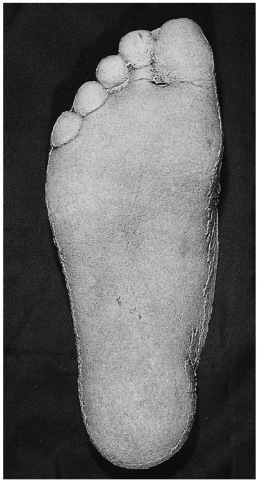
Figure 1 Dental stone cast, made from a foam impression material.
Barefoot impressions in shoes
We take thousands of steps every day, generating heat and sweat which cause the shoe to stretch and conform to the shape of the foot. The weight-bearing areas of the foot, including the toe pads, cause stains and indentations inside the shoe. It is these areas that are compared. If the footwear has damage, such as a nail coming through the insole, or the stitching causing a wrinkle on the inside of the footwear, then these abnormalities can injure the foot, causing accidental characteristics. It is these characteristics that are used during the forensic analysis.
When the crime scene investigator is trying to establish a link between a barefoot impression of a suspect and an impression on the insole of a shoe which was found at or has been matched back to the crime scene, it is preferable to obtain a pair of shoes from the suspect for comparison. The comparison is started by examining the outsole of both the known footwear and the suspect footwear for similar wear patterns. The heel of each shoe is examined for wear. This wear should be consistent from shoe to shoe if the same person wore both shoes. The wear pattern on the ball of the foot is then compared and this also should be consistent in each shoe, if worn by the same person (Fig. 2). The shoe is then taken apart and the inside uppers and sides are examined for wear characteristics caused by either the tops of the toes or the sides of the toes and the ball of the foot, again looking for any damage that may have been caused by the foot (Fig. 3). The darkened and indented sweat impression found on the insole of the shoe is then examined and compared with the known shoe (Fig. 4). All the detail present in the shoe is examined in a similar manner to a barefoot comparison in order to form a conclusion.

Figure 2 Outsole of a running shoe, showing wear areas on the ball of the foot and the heel.
Other comparisons
The identification of barefoot impressions can also be used at times of mass disasters where the identification of human remains may be impossible, e.g. when only a legor foot may have been found. The foot or the footwear found on the remains can then be compared with a shoe taken from the victim’s home in order to link the victim of this disaster to his or her residence. This procedure may also be used when tryingto identify the remains of a missingperson, when dental or medical records are not available because of the age of the victim, or other unknown reasons.
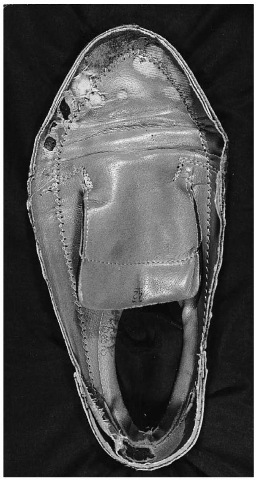
Figure 3 Inside top portion of a shoe, showing wear areas on the lining, caused by the top area of the toes.
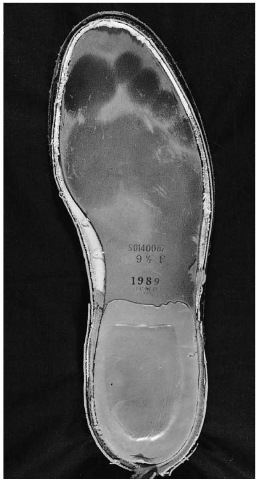
Figure 4 Insole of a shoe, showing the darkened and indented sweat areas caused by the weight-bearing areas of a bare foot.
Research
As mentioned earlier, barefoot comparison evidence has been presented in court a number of times, even though research into the uniqueness of footprints is incomplete. It is hoped that current work using computerized databases and statistical analysis may finally answer some of the questions related to barefoot morphology and provide the ability to identify or eliminate suspects.
A great deal of early research and casework in barefoot morphology was carried out in India, probably due to the fact that people there would be more likely to walk around barefoot or in sandals. For example, Puri, in 1965, described his work of classifying and measuring barefoot impressions for comparison purposes. In 1980, Qamra, Sharma and Kaila published the results of their preliminary study in-volving the measurements of the footprints of 725 individuals.
In North America, Dr Louise Robbins carried out studies on the individuality of human footprints in the 1970s. Other forensic investigators have at times collected footprints, of the order of 100 samples, in relation to an ongoing case to establish to the judicial system an idea of the individuality of foot morphology. On the other hand, a large study of 6800 subjects, carried out in 1981-1982 by the Prescription Footwear Association, was undertaken with an eye to lookingat how shoes fit, and the mismatching of feet for an individual, but not to show the uniqueness of barefoot impressions. Other collections of footprints have been taken in attempts to correlate foot measurements with height, weight, age or ethnic group.
The FBI has given evidence on barefoot morphology and has conducted considerable research in trying to establish the uniqueness of barefoot morphology. Their collection of impressions from 500 volunteers provided a starting point for studies of this nature. The Royal Canadian Mounted Police have been carrying out research on the uniqueness of barefoot impressions since 1989, and have extended this research considerably, with the collection of over 5000 pairs of barefoot impressions. This research attempts to prove the hypothesis that feet are unique to the individual by collecting inked walking barefoot impressions and entering the measurements of weight-bearing areas of the foot in a computer database. The computer program is capable of adding data to the system, and as entry of new data takes place, they are searched against all the data presently in the system to determine if a match exists. The system is capable of extracting data in any order for analysis by mathematicians and statisticians (Fig. 5).
Uniqueness of Bare Feet
Over time, as a person grows, the length and width of the foot, the shape and placement of the pads of the toes, the ball of the foot and the heel can change randomly and be affected by our environment. Before our bones ossify, they can be forced to grow improperly by the type of shoes worn, the type of activities we do or the injuries that sometimes happen over time. When growth stops, it has been shown that barefoot impressions will remain unchanged, unless affected by injury. In addition to injury to the foot itself, injury to the back, hip, knee or legcan cause the individual to walk differently and thus change the weight-bearing areas of the foot. Research has shown barefoot impressions over several years from the same adult person have remained unchanged. Impressions from inside several pairs of footwear that were worn over a 25 year period were examined and showed little change in the weight-bearing areas on the insole of the footwear. Many walking impressions taken from individuals over a distance of 5-6 m exhibit little or no change in the weight-bearing areas transferred to the paper.
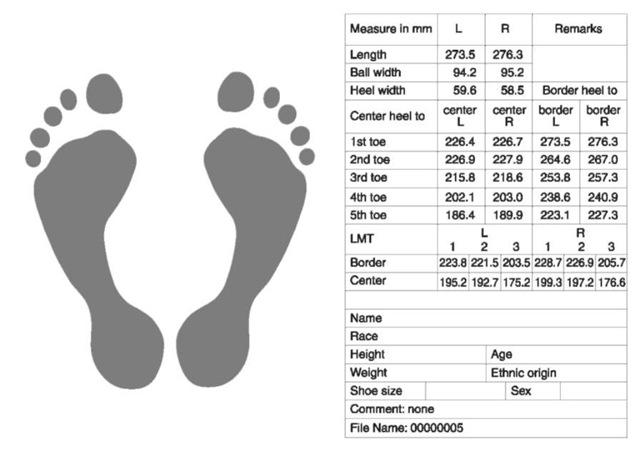
Figure 5 Printout from computer database showing the tracing of the weight-bearing areas of a pair of bare feet. The data box shows some of the data gathered by the computer and the history box shows the personal information of the individual. LMT, length of metatarsal.
Barefoot impressions have also been taken from several pairs of identical twins, and in each case their barefoot impressions were distinct one from the other (Fig. 6).
We are all genetically different and it is simply a matter of training ourselves to observe these differences in order to establish individualization. This fact is proven in the examination of our DNA, our fingerprints and even our facial features. Each of us is capable of observing features and forming an opinion of identification without realizingit. We start very early in life recognizing the features of our parents’ faces. A typical human face has two eyes, a nose, a mouth and two ears, all in generally the same location, and yet everyone looks different, and we can recognize these differences because of many years of looking at faces. Our brain quickly analyzes, compares and evaluates each feature in order to reach a conclusion as to the identification of that person. This process is the same when doing any physical comparison. To the untrained eye, for example, a fingerprint is nothing more than a finger mark, but it is through the comparison process that a technician can see the uniqueness of the detail in the print and individualize a fingerprint to a particular person.
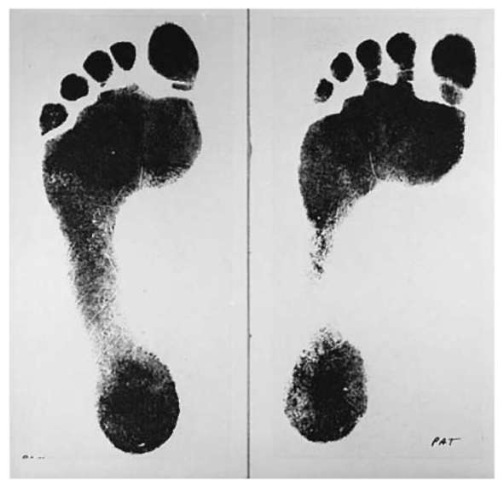
Figure 6 Inked barefoot impressions of the left feet of a pair of identical twins. This shows the differences between the placement of the toes, the presence of toe stems, and a high arch in one of the twins.
Initial research indicates that bare feet have characteristics that may form the basis for identification. While some research remains to be done to prove this hypothesis, barefoot impressions can still be compared in order to eliminate or link a suspect to the scene of a crime.
